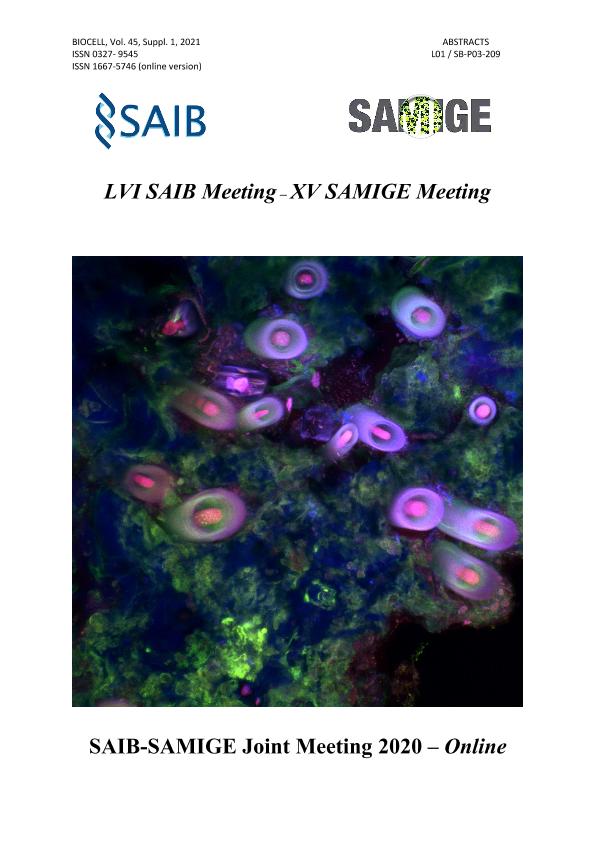Mostrar el registro sencillo del ítem
dc.contributor.author
Sheridan, María Luján

dc.contributor.author
Gomez, Maria Sol

dc.contributor.author
Casati, Paula

dc.date.available
2023-09-13T15:13:52Z
dc.date.issued
2020
dc.identifier.citation
Analysis of E2FA protein in the response of arabidopsis thaliana plants to UV-B radiation; LVI Annual Meeting Argentine Society for Biochemistry and Molecular Biology; XV Annual Meeting Argentinean Society for General Microbiology; Argentina; 2020; 64-64
dc.identifier.uri
http://hdl.handle.net/11336/211382
dc.description.abstract
Plants use sunlight to direct and regulate essential processes. Among the components of solar radiation is UV-B radiation (280-315 nm) that at high intensities generates harmful effects on plants. Because of this, plants have developed multiple mechanisms of tolerance and adaptation to UV-B radiation. Among the effects caused by high doses of UV-B radiation in plants are damage to DNA, lipids and proteins. Two common plant phenotypes after UV-B exposure are inhibition of leaf growth and primary root elongation.The shape and architecture of plants are determined by processes that modulate growth and differentiation of organs, which control the number, size and type of cells that constitute them. One of the pathways involved in the regulation of cell division, growth and differentiation is the Retinoblastoma pathway, in which the Retinoblastoma protein (RBR), the E2F transcription factors and the DP dimerization proteins participate. This pathway regulates the G1/S cell cycle transition, one of the key stages of cell cycle control in eukaryotes. E2F transcription factors serve crucial and antagonistic roles in several pathways related to cell division, DNA repair, and differentiation. In particular, E2Fa activates transcription binding to DNA cooperatively with DP proteins through a specific recognition site that is found in the promoter region of several genes whose products are involved in cell cycle regulation or DNA replication.Based on this, the aim of this work is to understand the participation of E2F transcription factors, in particular E2Fa, in the response of Arabidopsis thaliana plants to ultraviolet-B radiation. In the laboratory, using mutant lines in the E2Fa gene (e2fa-1), we observed that the primary roots are less affected by a treatment with UV-B radiation than WT lines, when we analyzed their elongation and also at the cellular level. In addition, the primary roots of e2fa mutants showed significantly fewer dead meristematic cells after a UV-B treatment than WT plants. Regarding the aerial part of the plants, we also found that growth of the proliferating leaves of e2fa-1 lines is less affected by UV-B radiation than the WT leaves. Together, these results suggest that E2Fa regulates growth, development and programmed cell death in response to UV-B radiation.
dc.format
application/pdf
dc.language.iso
spa
dc.publisher
Tech Science Press

dc.rights
info:eu-repo/semantics/openAccess
dc.rights.uri
https://creativecommons.org/licenses/by/2.5/ar/
dc.subject
UV-B
dc.subject
Cell cycle
dc.subject
E2F
dc.subject
arabidopsis
dc.subject.classification
Bioquímica y Biología Molecular

dc.subject.classification
Ciencias Biológicas

dc.subject.classification
CIENCIAS NATURALES Y EXACTAS

dc.title
Analysis of E2FA protein in the response of arabidopsis thaliana plants to UV-B radiation
dc.type
info:eu-repo/semantics/publishedVersion
dc.type
info:eu-repo/semantics/conferenceObject
dc.type
info:ar-repo/semantics/documento de conferencia
dc.date.updated
2022-12-12T23:16:32Z
dc.journal.volume
45
dc.journal.number
Suplemento 1
dc.journal.pagination
64-64
dc.journal.pais
Estados Unidos

dc.description.fil
Fil: Sheridan, María Luján. Consejo Nacional de Investigaciones Científicas y Técnicas. Centro Científico Tecnológico Conicet - Rosario. Centro de Estudios Fotosintéticos y Bioquímicos. Universidad Nacional de Rosario. Facultad de Ciencias Bioquímicas y Farmacéuticas. Centro de Estudios Fotosintéticos y Bioquímicos; Argentina
dc.description.fil
Fil: Gomez, Maria Sol. Consejo Nacional de Investigaciones Científicas y Técnicas. Centro Científico Tecnológico Conicet - Rosario. Centro de Estudios Fotosintéticos y Bioquímicos. Universidad Nacional de Rosario. Facultad de Ciencias Bioquímicas y Farmacéuticas. Centro de Estudios Fotosintéticos y Bioquímicos; Argentina
dc.description.fil
Fil: Casati, Paula. Consejo Nacional de Investigaciones Científicas y Técnicas. Centro Científico Tecnológico Conicet - Rosario. Centro de Estudios Fotosintéticos y Bioquímicos. Universidad Nacional de Rosario. Facultad de Ciencias Bioquímicas y Farmacéuticas. Centro de Estudios Fotosintéticos y Bioquímicos; Argentina
dc.relation.alternativeid
info:eu-repo/semantics/altIdentifier/url/http://www.saib.org.ar/sites/default/files/BIOCELL-SAIB-2020-version-final.pdf
dc.conicet.rol
Autor

dc.conicet.rol
Autor

dc.conicet.rol
Autor

dc.coverage
Nacional
dc.type.subtype
Reunión
dc.description.nombreEvento
LVI Annual Meeting Argentine Society for Biochemistry and Molecular Biology; XV Annual Meeting Argentinean Society for General Microbiology
dc.date.evento
2020-11-02
dc.description.paisEvento
Argentina

dc.type.publicacion
Journal
dc.description.institucionOrganizadora
Sociedad Argentina de Investigación en Bioquímica y Biología Molecular
dc.description.institucionOrganizadora
Sociedad Argentina de Microbiología General
dc.source.revista
Biocell

dc.date.eventoHasta
2020-11-06
dc.type
Reunión
Archivos asociados
